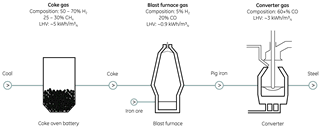Использование побочных газов металлургического производства

gases from steel production processes can provide an energy source
High levels of power requirement and rising energy costs represent a major challenge for the steel industry. Gases created as a “free” by-product during steel production processes serve as an attractive energy source option for efficient power generation. In addition to the economic benefit, using these gases as engine fuel reduces industrial CO2 emissions and saves natural energy sources.
different gases from steel production processes
Steel production processes typically dispose large volumes of specialty gases. Three different process stages – from coal to steel – provide three different gas types: coke gas, blast furnace gas and converter gas. These gases, with different compositions and lower heating values (LHV), are shown in the following figure:

the Jenbacher concept
Varying compositions, as well as calorific values and the combustion behavior of gases from steel production processes, put greater demands on engine design. GE offers specially modified Jenbacher gas engines that make efficient use of these gases for combined generation of heat and electricity.
In general, the stable composition of coke gas makes it advantageous as an engine fuel. The high hydrogen content of coke gas, however, means the combustion process is very fast, which increases the danger of engine knocking or backfiring. To avoid this risk, GE has created an engine control system that is able to fuel the Jenbacher engine with a very lean mixture and, at the same time, react very quickly to variations in the engine load.
Converter gas, with its high carbon monoxide content, has low combustion speed and is very harmful. GE has developed the specific Jenbacher engine combustion system that allows burning the gas efficiently and reliably. Additionally, GE offers a safety technology package that allows firm handling of harmful gases such as carbon monoxide.
Both gases can be used to create hot water, steam and electricity. The hot water and exhaust gases from the gas engines are fed into boilers. The resulting steam can be used within the steel production processes. Electricity generated by the Jenbacher engines can either be used on-site or sold to the public grid. Converter gas electrical efficiencies of up to 37% can be achieved, and coke gas efficiencies are even higher.
GE provides highly developed Jenbacher gas engine technology for efficient power generation with coke gas and converter gas.
coke gas
VA by-product of industrial coke production from pit coal, coke gas is created by high-temperature dry distillation of coking coals in the absence of oxygen. The gas mainly consists of hydrogen (50 to 60%), methane (15 to 30%) and a small percentage (10 to 20%) of carbon monoxide, carbon dioxide and nitrogen. With a calorific value of 5 kWh/m?N, coke gas constitutes a high-value fuel for effective power generation with Jenbacher gas engines.
converter gas
Converter gas is created from pig iron during the steel production process. Steel-making technology can be categorized into two different processes: blow moulding or open hearth.
Within the blow moulding process, the pig iron is refined with oxygen or air, lowering the carbon proportion and providing enough process heat to maintain the steel liquid. With 60% of the worldwide raw steel production, the Linz-Donawitz (LD) process, classified as a blow moulding process, is the most common production method to generate raw steel.
On the other hand, the open hearth process extracts the oxygen of the added scrap and ore, requiring additional heat supply for the steel-making process. One of the most common open hearth processes is the electrical melting process.
Converter gas from the LD and electrical melting processes can be used in Jenbacher gas engines. The gas consists of about 65% carbon monoxide, 15% carbon dioxide, 15% nitrogen and small amounts of hydrogen and methane.
advantages
- Independent power supply
- Reduced energy costs, and greater predictability and stability
- Efficient and economic combined heat and electricity supply
- High electrical efficiency compared to other power generation technology (e.g., steam or gas turbines)
- Best suited for an electrical output range of a few hundred kW up to 20 to 30 MW
- Considerably low gas pressure required
- Alternative disposal of a problem gas while simultaneously harnessing it as an energy source
- Substitute to conventional fuels
- Environmental benefits by greenhouse gas reduction
key figures
Per ton of produced coke approximately 470 m3N coke gas are produced; 60% of this volume is typically needed for internal processes, the remaining part can be used for power generation with Jenbacher gas engines resulting in about 400 kWh electrical energy. Per ton of steel produced through the LD process approximately 50 m3N converter gas are released, which can be burned in Jenbacher gas engines leading to about 50 kWh electrical power.
our competence
Substantial research has been completed on this application. GE installed its first commercial Jenbacher gas engine applications for coke gas already in 1995, and for LD converter gas in 2004. About 30 Jenbacher gas engines now run on either coke gas or LD converter gas. Underscoring GE’s technological expertise, these units recently reached a combined total of more than 1 million operating hours. In addition, by utilizing these “free” waste gases compared to using natural gas for power generation, the Jenbacher-technology equipped sites have achieved CO2 emission savings of about 2 million tons since commissioning.